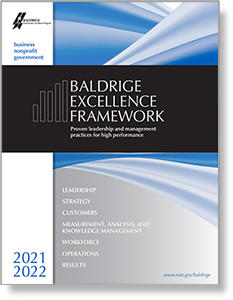Blogrige
The Official Baldrige Blog

I believe we have reached an inflection point for governance boards (aka boards of directors) as we enter the "new normal" for organizations and society as a whole. Boards in 2021 will need to place a significant focus on ten critical areas. (I hesitate to call them the Big Ten because college sports fans will immediately think there are 14.) These ten areas are based on numerous published studies (some key ones are referenced in this blog post) and my own experiences over the last year. While this blog is focused on boards of directors, many of the critical focus areas also apply to CEO's and other senior organizational leaders.
Introduction
It is no surprise that data published by McKinsey & Company on May 4, 2021 indicate that boards increased their attention in 2020 on corporate (organizational) resilience and that every other topic dropped in attention. Attention to resilience rose from 44% to 60%, while focus on major societal trends and workforce-related topics dropped by 13% and 9-10%, respectively. While resilience certainly continues to be important in 2021, other topics are demanding increasing attention. I have summarized my top ten topics below, recognizing that there frequently is overlap among these topics when organizations take a systems perspective to leadership and management. After sharing the ten areas, I will relate them to board responsibilities and the Baldrige framework's core values.
Ten Critical Areas
1. Lessons from the Past Year
This has been an unprecedented year, characterized by a pandemic, the likes of which almost all of us had never experienced before, and by the emergence of a long-overdue call for true social justice in the United States. We all reacted, personally and organizationally, to the rapidly evolving environment. Organizations with effective resiliency plans did relatively well and were role models for community resilience, as well.
One notable characteristic of the resilient organizations was their ability to rapidly shift communication mechanisms and establish two-way, remote communication with employees, customers, and other key stakeholders virtually "overnight." We have all learned the importance of communication and listening over the last year.
Of course, our experiences over the last year go beyond adapting to new communication modes. We have experienced and learned a lot. Now it is time to consolidate those lessons learned and make them part of our strategic, operational, and resiliency plans, rather than dive head-first into disorganized and differing perceptions of the "new normal."
2. Risk Management
Having come through this past year, boards and senior leaders need to assess if their organizations' crisis management plans were up to the challenges they faced. Going forward, all organizations will need to develop a (refreshed) enterprise risk-management plan. According to a McKinsey recommendation on board responsibilities, enterprise risk, culture, and strategy will need to be embedded in all board decisions and to be treated in an aligned fashion.
Risk management is about preparing for an uncertain future. Among the current uncertainties are how many of the myriad changes we have made and experienced during the past year will prove permanent and which of the changes will either revert to a former state or to a new and different state. In its discussion of the new era of board stewardship, Deloitte Insights 2021 Directors' Alert states that "strong and resilient boards will have the diversity of skills and backgrounds to make reasoned assumptions about the present and the future...steering the organization through turbulent times." According to a Harvard Law School Forum on Corporate Governance in 2021, after the pandemic, key risk considerations for the boards must be cybersecurity, data protection, and legal compliance.
There appears to be fairly unanimous agreement among a cross-section of experts that an important component of risk management for boards is related to organizational leadership. Were the senior leaders of the organization up to the leadership challenge they faced during the past year? Are there emergency replacements who are capable of stepping in if a crisis impacts a senior leader? Abraham Lincoln cautioned against changing horses mid-stream, but he also was keenly aware of the risk of keeping an unprepared leader at the helm of an organization. One of Lincoln's leadership principles was to keep seeking "until you find your Grant." In other words, give every leader a chance, but if they are not up to the job they need to be replaced, even during the heat of battle. Thus, he made numerous leadership changes until he installed General Ulysses S. Grant. How well is your organization set for leadership?
The National Association of Corporate Directors (NACD) in its 2021 Governance Outlook states that boards will face heightened expectations to apply a "mission-critical" risk framework in their oversight. They cite several court decisions where the mission criticality of an action or lack of action led to the court's decisions. In an era where organizational missions and purposes are being challenged and redefined, this board oversight focus is increasingly important.
The NACD report further states that board committee charters should be reviewed annually and updated, if necessary, to reflect key areas of risk in the committee's oversight purview. Committees (and the full board, if needed) should be charged with timely review of existing risks and should also, with organizational senior leadership guidance, address new or evolving risks.

3. Mission and Purpose
The Baldrige Excellence Framework's glossary of key terms defines mission as your organization's overall function. It answers the question, "What is your organization trying to accomplish?" Some organizations also define a larger purpose for existence. This purpose defines the fundamental reason the organization exists. It inspires the organization. Purpose guides the setting of an organization's values. Mission is guided by the organization's values.
As organizations are called on to serve a larger set of stakeholders than shareholders and customers, boards play a key role in setting and overseeing that higher purpose. Many corporations have adopted the Business Roundtable's 2019 "Statement on the Purpose of a Corporation" that calls for a shift away from shareholder primacy toward a broader view of responsibility and accountability to a wider group of stakeholders.
In its 2021 Governance Outlook, the NACD states that boards have a role in understanding the organization's key stakeholders, how they are identified by senior leadership, the impact of the organization on these stakeholders, and any related risks.
A clear statement of purpose that brings value to society provides a basis for leadership and board decisions and enhanced employee and customer engagement. Furthermore, a meaningful statement of purpose reinforces a strong organizational culture, allowing everyone to celebrate organizational contributions, which is especially valuable during and right after times of crises.
4. Diversity, Equity, and Inclusion (DEI)
Both the Harvard Law School Forum on Corporate Governance and NACD's 2021 Governance Outlook call for two perspectives on DEI. The first perspective is a risk-based perspective, with growing demands for transparency and accountability regarding equity considerations within the workforce. For publicly traded and for public-benefit organizations, stockholders and contributors want numeric data to track progress on diversity and equity in the workforce, so they can decide where to invest their money and time.
The second—and, in my opinion, more important—focus, is on proactively addressing DEI opportunities for the organization. Boards should work with organizational leaders to ensure diversity, equity, and inclusion in hiring, promotion, senior leadership presence, and board membership. Boards and organizations need to consider DEI as part of strategic planning. Boards should work with their organization's leadership to assess business practices for unintentionally discriminatory processes related to the treatment of employees, customers, and communities served.
5. Societal Contributions
Organizations are increasingly measured on environmental, social, and governance (ESG) contributions. There is a growing sensitivity to these considerations in consumer spending and investor decisions, in employees' choice of where to work, and in charitable giving. And this sensitivity has been heightened during the past year. Being role-model citizens in the community that houses the organization adds value to the organization's reputation and stature.
How an organization addresses ESG is an important part of continuity planning and strategy and thus is a board-level consideration. Public disclosure of commitments is considered an important reputational issue. Therefore, boards should also ensure that an organization's ESG commitment is borne out in action.
6. Strategy
Strategy has always been a significant topic for governance boards. Deloitte in its 2021 Directors Alert states that changes in business models loom particularly large as organizations emerge from the pandemic. The nature of work and the workplace have also changed dramatically and will impact strategic planning as organizations plan for the new normal and beyond. Employee retention will be a challenge as competition for workforce members heats up. Boards need to pay attention to all aspects of workforce management, including the special attention to DEI I mentioned in #4 above.
As organizations experience the new normal in their business environment, there is an expectation that there will be new and continuing short-term pressures on organizations, including the heightened attention to cybersecurity I referenced in #2. Boards have a responsibility to balance those short-term pressures with a longer-term sustainability strategy for the organization. This means some attention to strategy will become part of every board meeting for organizations. Addressing vulnerabilities and associated strategic risks will require the varied expertise of a diverse board with differing individual insights.
7. Innovation and Strategic Opportunities
Along with new vulnerabilities, crises always present new opportunities. Boards need to ensure that such opportunities are identified and evaluated for the strategic benefit they might provide. McKinsey highlights strategic opportunities related to all aspects of digitization and the acceleration of consumer expectations. Remote work has led to innovations that might generate strategic advantages going forward. Ideas have come from all parts of the organization during the past year. Boards need to work with senior organizational leaders to see that these ideas are captured and evaluated for strategic opportunities.
8. Support for Senior Leaders
Senior leaders (and all employees) have likely experienced the most challenging year of their tenure as leaders (or employees). Boards need to give their organizations' leaders emotional support and an attentive ear. They also need to decide what feedback to give senior executives, how to adjust their goals, and how to evaluate their performance for this challenging year. In making compensation decisions, the Harvard Law School Forum included particular mention of the board's need to balance rewarding leaders' hard work and high performance with any perception brought on by employee furloughs, layoffs, or downsizing.
Maybe it is most important—after a year in which many boards took on added roles—for boards to bear in mind the difference between the oversight role of the board and the leadership role of senior leaders and to respect the difference as the new normal emerges.
9. Team Dynamics
There are two aspects of team dynamics that need board consideration:
- Boards, like workforce members, have learned to operate through videoconferencing and "remote work." How has that impacted board dynamics? What has changed that should be preserved? Are there new board members who have never received a proper orientation or met the other board members? Would an internal board feedback session be appropriate?
- Team dynamics within the organization have changed. People and teams have become more empowered. Senior leaders have established changed relationships with middle managers and the empowered teams. Boards need to help senior leaders adapt to and adopt changes that should be preserved.
10. Speed of Decisions
The urgency of the past year has led to new and faster decision-making processes at all levels of the organization. It is time to look at permanently modifying processes for speed. It is also time to recalibrate decision-making processes to ensure that the need for speed has not replaced the use of data- and fact-based decision making when that is needed.
Board Responsibilities and the Baldrige Core Values
The Baldrige Excellence Framework is underpinned by a set of 11 core values and concepts. These core values have served as the basis for defining role-model attributes for boards of directors' performance. Now is a good time to take a fresh look at these role-model characteristics as boards recalibrate themselves for "new normal" operation and want to make sure they do so with a clear picture of their role and the organizational senior leaders' role.
Let me share some thoughts on a few of the Baldrige core values, in particular, as boards recalibrate:
- Ensuring a systems perspective: Boards need to make sure that senior leaders are taking a holistic look at the organization and its many functions and processes. Now is a good time to reconsider the larger ecosystem (partners, suppliers, customers, communities) in which the organization operates.
- Focus on organizational success (sustainability): Boards need to work with senior leaders to create a focus on short- and longer-term factors that affect the organization, its reputation, and its ongoing success. They need to focus on the “big picture,” ensuring that organizational planning anticipates future marketplace, economic, and technological influences and disruptions.
- Ensuring ethics and transparency: Boards and senior leaders need to set the tone for ethical and transparent operation of the organization. Has the organization and the board remained true to its ethical principles over the last year? Might now be the time for an audit? Might this provide the opportunity to become the ethical role model you want the organization to be for the future?
The next board meeting is the time to set the tone for the future. What tone will your board set?
Resources
Am I an Inclusive Leader? (March 2021)
C – V = D (Culture Minus Values Equals Destiny) (December 2020)
Archived Columns

Baldrige Excellence Framework
The Baldrige Excellence Framework has empowered organizations to accomplish their missions, improve results, and become more competitive. It includes the Criteria for Performance Excellence, core values and concepts, and guidelines for evaluating your processes and results.
Purchase your copy today!
Available versions: Business/Nonprofit, Education, and Health Care






thank so considerably for your web site it assists a lot.